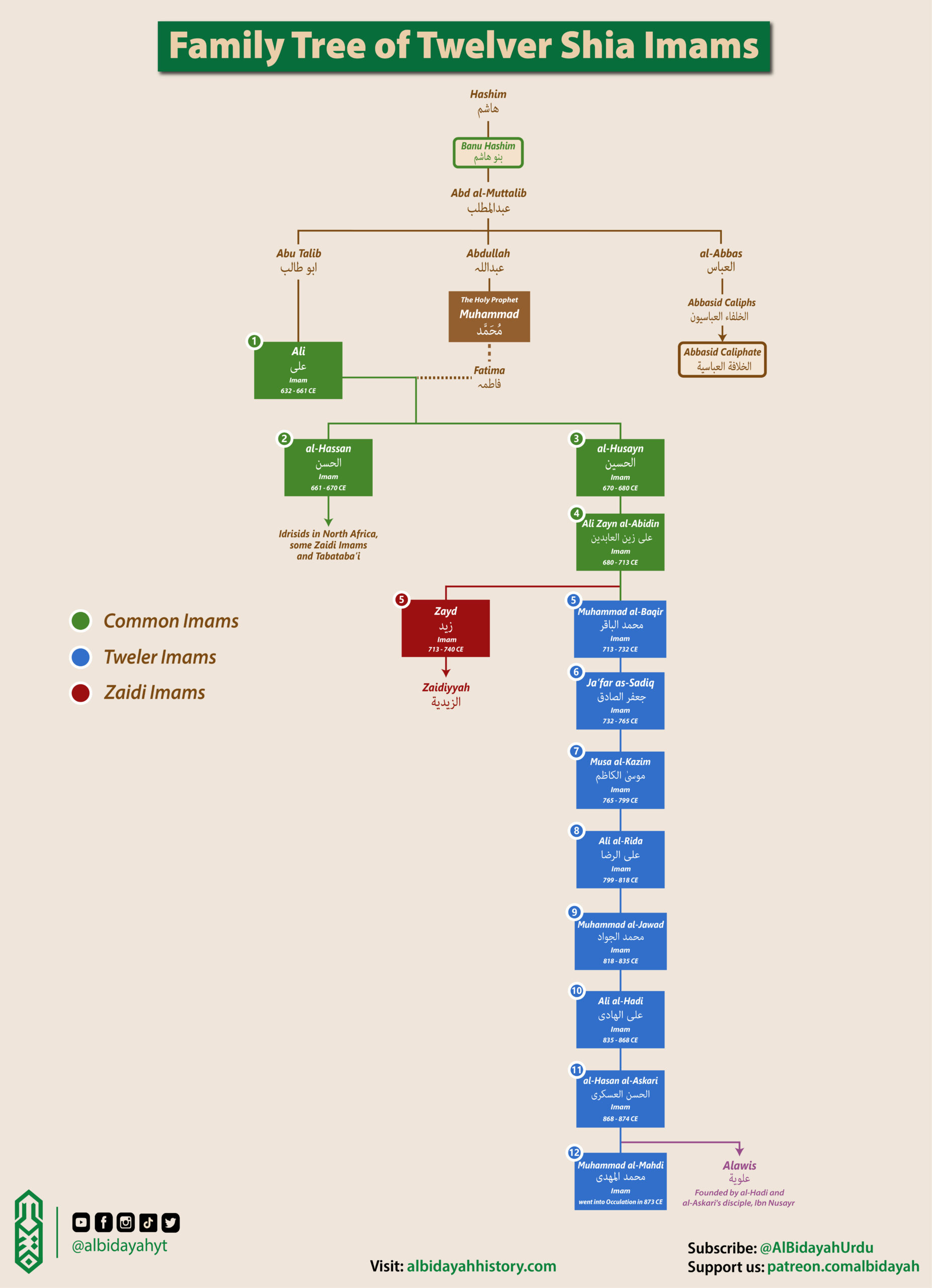The Twelver Imams or Ithna ‘Ashariyya Imams family tree begins with Hashim, head of the Banu Hashim clan, leading to Abd al-Muttalib, whose lineage branched into significant historical figures. From Abu Talib comes Imam Ali (1st Imam), married to Fatima, the daughter of Prophet Muhammad (PBUH), marking the root of the Imamate.

The Foundation of Leadership
Following the death of the Prophet Muhammad (PBUH), a significant disagreement arose over who should succeed him as both the political and spiritual leader of the Muslim community. While Sunni Muslims chose Abu Bakr as the first caliph, Shia Muslims believe that the Prophet had designated his cousin and son-in-law, Ali, as his rightful successor. This marked the beginning of the division between Sunni and Shia Islam.
The Shia belief in the imamate is based on the principle that leadership must remain within the Prophet’s family, passing down through the descendants of Ali and Fatimah, the Prophet’s daughter. This lineage forms the core of Shia religious and spiritual authority.
The Lineage of the Twelve Imams
The following are the key imams in the Twelver Sunni and Shia tradition, which believes in a line of twelve imams. Each of these leaders is considered infallible and divinely appointed.
1. Ali ibn Abi Talib (600–661 AD/CE)
- The First Imam: Ali, the Prophet’s cousin, and son-in-law, was the first imam according to Shia belief. He was renowned for his wisdom, leadership, and justice. His assassination in 661 CE marked a significant moment in early Islamic history.
2. Hasan ibn Ali (625–670 AD/CE)
- The Second Imam: Hasan, the eldest son of Ali, succeeded him as the second imam. Known for his efforts to preserve peace, he abdicated the caliphate in favor of Muawiyah I, a decision that caused much internal strife among the Muslim community.
3. Husayn ibn Ali (626–680 AD/CE)
- The Third Imam: Husayn, younger son of Ali, is one of the most significant figures in Shia Islam. His martyrdom at the Battle of Karbala is commemorated annually on Ashura and symbolizes the ultimate stand against injustice.
4. Ali Zayn al-Abidin (659–713 AD/CE)
- The Fourth Imam: Ali Zayn al-Abidin, a survivor of Karbala, was known for his devotion to worship and his famous collection of supplications, Sahifa al-Sajjadiyya.
5. Muhammad al-Baqir (676–733 AD/CE)
- The Fifth Imam: Imam al-Baqir contributed significantly to Islamic jurisprudence, laying the foundations for the religious sciences that his successors would continue to develop.
See Also: Prophet Muhammad (PBUH) Family Tree: Quraysh to Imam Mahdi
6. Ja’far al-Sadiq (702–765 AD/CE)
- The Sixth Imam: Ja’far al-Sadiq is one of the most prominent imams, with contributions that extended to both Sunni and Shia thought. He had many students, including founders of Sunni legal schools.
7. Musa al-Kadhim (745–799 AD/CE)
- The Seventh Imam: Musa al-Kadhim’s life was marked by imprisonment and eventual martyrdom due to his opposition to the ruling Abbasid caliphs.
8. Ali al-Ridha (766–818 AD/CE)
- The Eighth Imam: Imam al-Ridha became known during the reign of the Abbasid Caliph al-Ma’mun, who named him as his successor, although this move was more political than genuine, leading to al-Ridha’s eventual poisoning.
9. Muhammad al-Jawad (811–835 AD/CE)
- The Ninth Imam: Despite his young age, Muhammad al-Jawad was renowned for his intellect and leadership, though his life was cut short under the Abbasid regime.
10. Ali al-Hadi (829–868 AD/CE)
- The Tenth Imam: Ali al-Hadi’s leadership was heavily restricted by the Abbasid caliphs, but he continued to guide the Shia community through a discreet network of followers.
11. Hasan al-Askari (844–874 AD/CE)
- The Eleventh Imam: Imam al-Askari spent much of his life under house arrest. His death left the Shia community waiting for the emergence of his son, the Twelfth Imam.
12. Muhammad al-Mahdi (Born 868 AD/CE)
- The Twelfth Imam: Known as the Hidden Imam, al-Mahdi is believed by Twelver Shia Muslims to have gone into occultation. They await his return, when he will bring justice to the world as the messianic figure.
See Also: Banu Hashim Family Tree
Zayd ibn Ali: The Founder of the Zaydi Sect
In addition to the Twelver lineage of imams, there are other branches of Islam that recognize different successions. One of the most important figures in this context is Zayd ibn Ali (695–740 CE), the son of the fourth imam, Ali Zayn al-Abidin, and the brother of the fifth imam, Muhammad al-Baqir.
Zayd ibn Ali was a pious scholar and warrior who led a revolt against the Umayyad caliphs, seeking to restore justice and bring an end to their oppressive rule. His revolt was ultimately unsuccessful, and he was martyred in battle. Despite this, his followers—known as the Zaydis—continued to regard him as a rightful imam.
The Zaydi Imamate: A Unique Branch
The Zaydi sect, also known as “Fiver Shia,” differs from Twelver Shia by recognizing only five imams and allowing any descendant of Hasan or Husayn who demonstrates knowledge and justice to become an imam. Unlike Twelvers, they do not believe in an infallible or hidden imam.
Zaydi imams have historically ruled in Yemen for centuries, influencing the region’s politics and religion. Zaydi theology shares similarities with Sunni Islam in legal and doctrinal aspects, but it maintains the Shia belief in the Prophet’s family as rightful leaders.



